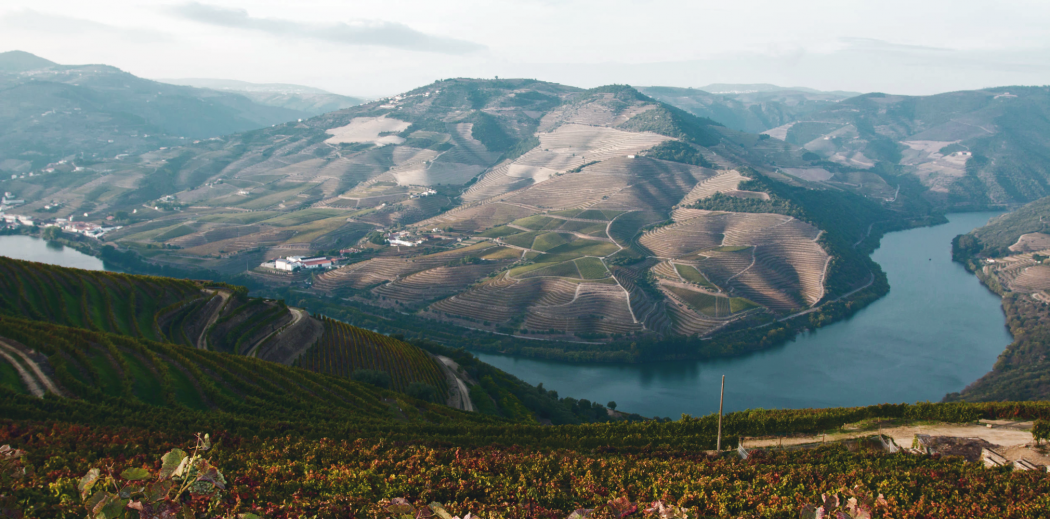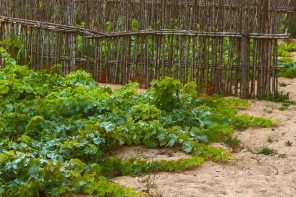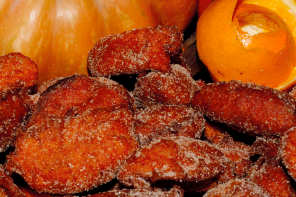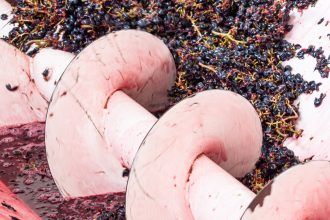A couple hours on a Portuguese train will have anyone thirsty for a nicely aged port. I felt particularly welcomed when – after brushing off the ride from busy Porto – Antonio, my Airbnb host/tour guide, greeted me in Peso da Régua with a taste of his grandfather’s 1957 port. Though he makes his own, he told me, it’s far too young to be drunk now. His grandchildren will enjoy it. A short lesson from Antonio about the wine, a few swirls and a joke about port being the local men’s fragrance of choice, and I was hooked on the Douro Valley.
Together, with Antonio’s brother at the wheel and Antonio relaying history, facts and jokes to me in the backseat, we drove up and up into the hills of Douro. We wound past rows of cascading vineyards that seemed they would tumble down the mountain if not for the stone walls built up to support them. It was a misty day, which made the view from Miradouro de Santo Antonio, with the sun peeking out in the distance, that much more majestic.
At the center of town, we stopped for a local snack of queijadas laranja, essentially mini orange cheesecakes. Next, it was the modern, interactive Museu do Douro for us, which taps into the heartbeat of the current-day wine traveler with interactive exhibits. The museum is well worth the visit, as it offers up pretty much everything there is to know about the region’s history and port wines.
Peso da Régua is not particularly quaint, but it’s surrounded by significant beauty that gives it a cache, just for its location. Régua is one of the many stops along the Douro River where port wine producers used to load their rabelas full of barrels and let loose down the river. These wooden river boats used to be manned by a handful of crew carrying the region’s most precious cargo toward Porto, where it would be bottled and sold. Before motors, sometimes the river’s rapids and rocks made the passage precarious, but these sailors didn’t stop until the delivery was made.
Today, a few rabelas still dot the riverscape today, but their bright tourism banners take away a bit of the romance. Instead of a boat ride, Antonio led me over the river by bridge to visit one of the most distinguished small-producing port wineries in the region.
Beautiful Quinta da Pacheca backs up to one of the most commercial wineries in the area, yet it’s very proud of its small production – only 250,000 bottles are sold each year. As most of the wineries around here do, Pacheca specializes in port wine, and they’re committed to making it the traditional way. That means each year, grapes are poured into large stone tubs, and groups of men are hired to stomp these grapes to separate the skins from the juice, Lucy and Ethel style. Sure, it’s more time-consuming – it can take four hours to crush one tub – but Pacheca and other traditional wineries swear by the higher quality of wine produced. It’s how they’ve been doing it for millennia.
But even before they were making wine thousands of years ago, people here were making art. Archaeologists recently uncovered some of the world’s oldest rock art, unique because it was done on open-air rock as opposed to in a cave, and mind-blowing because it’s roughly 25,000 years old. The carvings were discovered along the Côa River, a tributary of the Douro that runs south to north.
A few thousand years after that, and homo sapiens had advanced from artistic engravings made with prehistoric stone tools to the fine art of winemaking. Evidence of carbonized grape seeds among archeological sites along the Douro date Portugal’s winemaking history back to 4000 B.C. That makes the Douro Valley one of the oldest winemaking regions in the world.
This fact is an impressive feat considering the growing conditions along the valley and hills of northern Portugal. The steep grade of the hills that hug the riverbank was certainly a challenge for early wine producers and continues to be today. Vines need relatively flat ground in order to grow, and there’s not a hill in sight with less than a 30 percent grade. As a result, crafty vineyard growers began to construct stone walls that to this day stripe the side of each hill. It made the most sense since the terroir in the Douro Valley is mostly made up of schist (aka rock). Today, the vines dig their roots deep into the schist, which is great for drainage and gives the wines from here their distinct minerality.
With one cobblestoned main street, a one-lane bridge to cross the river, and three quintas (vineyards) within close walking distance, Pinhão has all the charm that Régua lacks. Quinta do Bomfim came recommended by a local, so that’s where I went to continue my port wine journey.
Another historical museum sucked me in at Bomfim – complete with old photos and handwritten letters – and then a few glasses of port on the windy terrace finish out the afternoon. Much of the port here was relatively young, including a very dry white port hadn’t benefitted from years in the barrel.
Less boutique than Régua’s Pacheca, Bomfim is part of a collective of vineyards in Douro, and it certainly has a more commercial flare. The grounds here are quiet and tidy, however, a hint at simpler times before wine tourism existed. Times, I recalled Antonio telling me earlier, that may not have been so far in the past. Tourism in the Douro Valley was relatively unheard of until about 10 to 15 years ago.
Since the Alto Douro Wine Region was inscribed as a World Heritage Site in 2001, the wine tourism industry has really taken off here. Today, more small producers are taking advantage of the trend to stay in business while still keeping out of the commercial trade. More tourists, in this case, could mean more authentic business in the Douro Valley.
And so, after leaving Bomfim, the weekend ended, and I crawled into my seat on the train in a haze of happy fulfillment. The three-hour train ride back to Porto doesn’t seem so long when you know a wine-induced nap will keep you busy. After all, the drink is required to be between 18 and 21 percent alcohol.
What did I learn? In Portugal’s northern wine country, history and wine are equally as rich and just as intoxicating. Douro’s authenticity is as palpable as a 59-year-old tawny port’s almond and caramel flavors.
And if you have the choice, always do as the Portuguese do – go for grandfather’s port.








